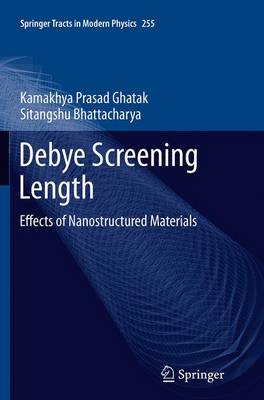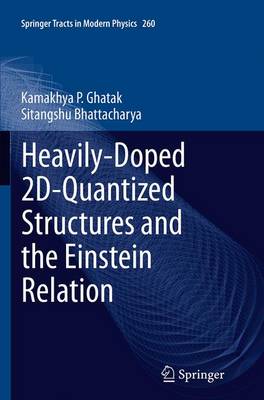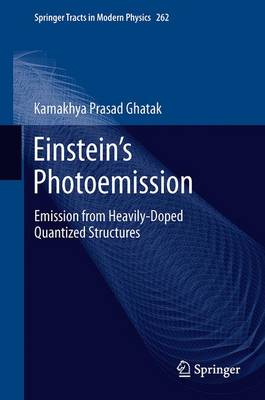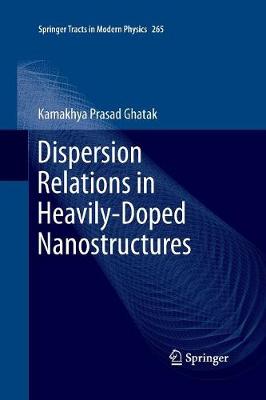Springer Tracts in Modern Physics
4 primary works
Book 255
Debye Screening Length
by Kamakhya Prasad Ghatak and Sitangshu Bhattacharya
Published 14 November 2013
This monograph solely investigates the Debye Screening Length (DSL) in semiconductors and their nano-structures. The materials considered are quantized structures of non-linear optical, III-V, II-VI, Ge, Te, Platinum Antimonide, stressed materials, Bismuth, GaP, Gallium Antimonide, II-V and Bismuth Telluride respectively. The DSL in opto-electronic materials and their quantum confined counterparts is studied in the presence of strong light waves and intense electric fields on the basis of newly formulated electron dispersion laws that control the studies of such quantum effect devices. The suggestions for the experimental determination of 2D and 3D DSL and the importance of measurement of band gap in optoelectronic materials under intense built-in electric field in nano devices and strong external photo excitation (for measuring photon induced physical properties) have also been discussed in this context. The influence of crossed electric and quantizing magnetic fields on the DSL and the DSL in heavily doped semiconductors and their nanostructures has been investigated. This monograph contains 150 open research problems which form the integral part of the text and are useful for both PhD students and researchers in the fields of solid-state sciences, materials science, nano-science and technology and allied fields in addition to the graduate courses in modern semiconductor nanostructures.
Book 260
Heavily-Doped 2D-Quantized Structures and the Einstein Relation
by Kamakhya P. Ghatak and Sitangshu Bhattacharya
Published 11 August 2014
This book presents the Einstein Relation(ER) in two-dimensional (2-D) Heavily Doped (HD) Quantized Structures. The materials considered are quantized structures of HD non-linear optical, III-V, II-VI, Ge, Te, Platinum Antimonide, stressed materials, GaP, Gallium Antimonide, II-V, Bismuth Telluride together with various types of HD superlattices and their Quantized counterparts respectively. The ER in HD opto-electronic materials and their nanostructures is studied in the presence of strong light waves and intense electric fields on the basis of newly formulated electron dispersion laws that control the studies of such quantum effect devices. The suggestion for the experimental determination of HD 2D and 3D ERs and the importance of measurement of band gap in HD optoelectronic materials under intense built-in electric field in nanodevices and strong external photo excitation (for measuring photon induced physical properties) are also discussed in this context. The influence of crossed electric and quantizing magnetic fields on the ER of the different 2D HD quantized structures (quantum wells, inversion and accumulation layers, quantum well HD superlattices and nipi structures) under different physical conditions is discussed in detail. This monograph contains 100 open research problems which form the integral part of the text and are useful for both Ph.D aspirants and researchers in the fields of condensed matter physics, solid-state sciences, materials science, nano-science and technology and allied fields.
Book 262
This monograph solely investigates the Einstein's Photoemission(EP) from Heavily Doped(HD) Quantized Structures on the basis of newly formulated electron dispersion laws. The materials considered are quantized structures of HD non-linear optical, III-V, II-VI, Ge, Te, Platinum Antimonide, stressed materials, GaP, Gallium Antimonide, II-V, Bismuth Telluride together with various types of HD superlattices and their Quantized counterparts respectively. The EP in HD opto-electronic materials and their nanostructures is studied in the presence of strong light waves and intense electric fields that control the studies of such quantum effect devices. The suggestions for the experimental determinations of different important physical quantities in HD 2D and 3D materials and the importance of measurement of band gap in HD optoelectronic materials under intense built-in electric field in nano devices and strong external photo excitation (for measuring physical properties in the presence of intense light waves which alter the electron energy spectra) have also been discussed in this context. The influence quantizing magnetic field, on the EP of the different HD quantized structures (quantum wells, quantum well HD superlattices and nipi structures) under different physical conditions has been investigated. This monograph contains 100 open research problems which form the integral part of the text and are useful for both Ph.D aspirants and researchers in the fields of materials science, condensed matter physics, solid-state sciences, nano-science and technology and allied fields in addition to the graduate courses in modern semiconductor nanostructures offered in different Universities and Institutes.
Book 265
Dispersion Relations in Heavily-Doped Nanostructures
by Kamakhya Prasad Ghatak
Published 23 November 2015
This book presents the dispersion relation in heavily doped nano-structures. The materials considered are III-V, II-VI, IV-VI, GaP, Ge, Platinum Antimonide, stressed, GaSb, Te, II-V, HgTe/CdTe superlattices and Bismuth Telluride semiconductors. The dispersion relation is discussed under magnetic quantization and on the basis of carrier energy spectra. The influences of magnetic field, magneto inversion, and magneto nipi structures on nano-structures is analyzed. The band structure of optoelectronic materials changes with photo-excitation in a fundamental way according to newly formulated electron dispersion laws. They control the quantum effect in optoelectronic devices in the presence of light. The measurement of band gaps in optoelectronic materials in the presence of external photo-excitation is displayed. The influences of magnetic quantization, crossed electric and quantizing fields, intense electric fields on the on the dispersion relation in heavily doped semiconductors and super-lattices are also discussed. This book contains 200 open research problems which form the integral part of the text and are useful for graduate students and researchers. The book is written for post graduate students, researchers and engineers.



